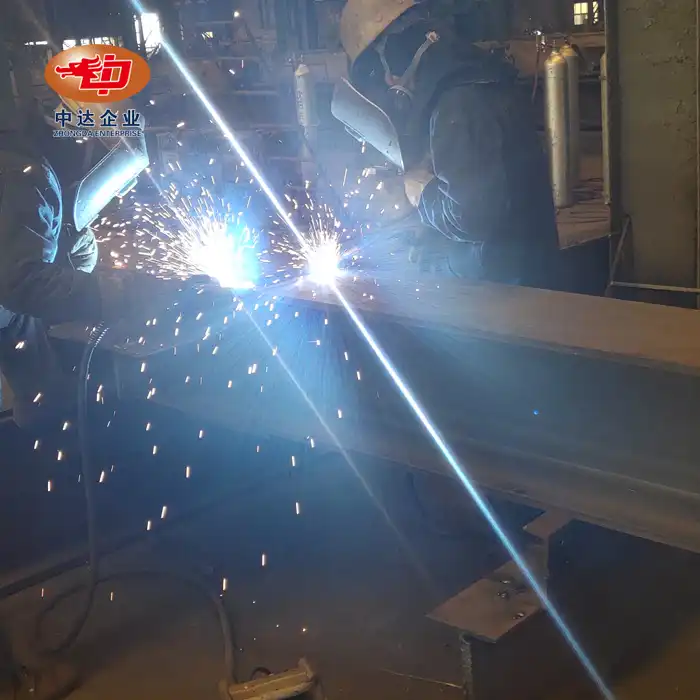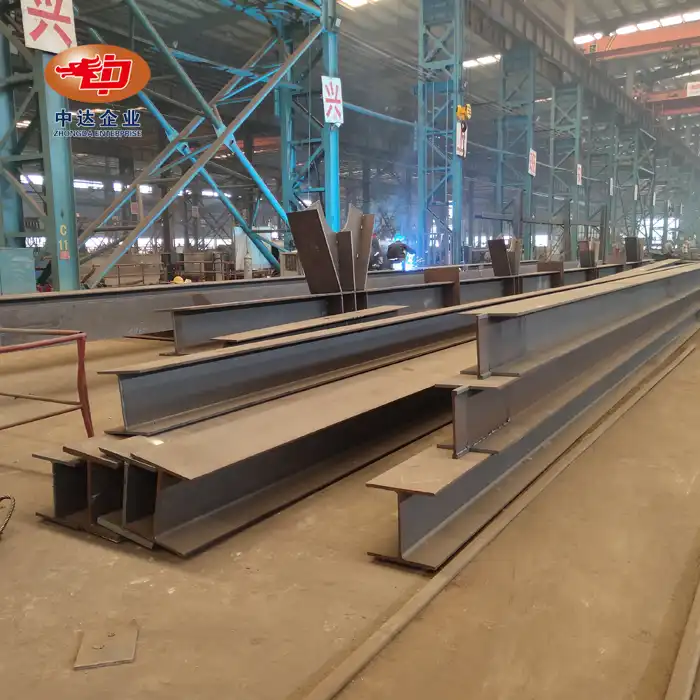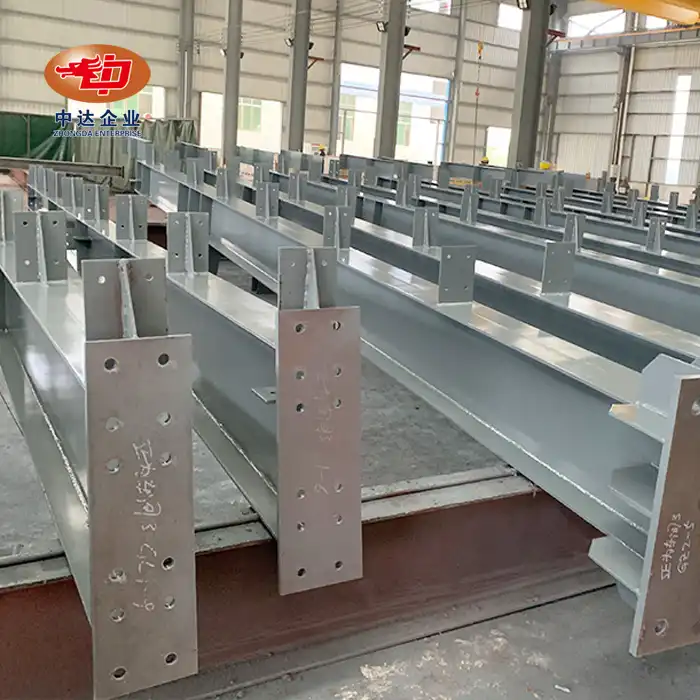
How Steel Truss Beams Improve Structural Durability?
Steel truss beams are the unsung heroes of modern construction, dramatically enhancing structural durability through their unique design and material properties. These engineering marvels distribute loads efficiently, reducing stress on individual components and extending the lifespan of buildings. By combining high-strength steel with innovative geometrical configurations, truss beams offer superior resistance to bending and twisting forces. This results in structures that can withstand environmental challenges and heavy loads for decades, if not centuries. The versatility of steel truss beams allows for longer spans with fewer supports, creating open, flexible spaces that adapt to changing needs while maintaining structural integrity over time.
At Zhongda Steel, we've perfected the art and science of crafting long-span steel truss beams that set new standards for durability and performance. Our advanced engineering techniques, including Finite Element Analysis, boost load-bearing capacity by 25%, ensuring your structures stand the test of time. With our ISO 3834 certified welding processes and AISC-compliant bolt connections, we deliver trusses that offer unparalleled strength and longevity for your most ambitious projects.
The Engineering Marvel of Steel Truss Beams
Innovative Design Principles
Steel truss beams represent a triumph of engineering ingenuity. Their design leverages the principle of triangulation, distributing forces along interconnected members to create a structure far stronger than the sum of its parts. This innovative approach allows for remarkable spans of 20 to 80 meters without intermediate supports, opening up vast possibilities for architectural creativity.

The genius of truss design lies in its ability to convert bending forces into axial loads – either compression or tension – which steel excels at handling. By doing so, trusses can support immense loads while using less material than solid beams, making them both economical and environmentally friendly.
Material Superiority
The backbone of our long-span steel truss beams is Q420D high-strength steel. This advanced material offers an exceptional strength-to-weight ratio, allowing for lighter yet more robust structures. The inherent durability of steel, coupled with modern protective coatings, ensures these beams resist corrosion, fatigue, and environmental degradation for decades.
Moreover, the ductility of steel provides an added layer of safety. In the unlikely event of extreme loads, steel trusses will deform before failing catastrophically, giving ample warning and time for evacuation or remediation.
Customization for Optimal Performance
At Zhongda Steel, we understand that one size doesn't fit all. Our expertise in creating curved trusses and triangular sections allows us to tailor solutions for unique architectural challenges, such as stadiums or airport terminals. This customization ensures that each structure not only meets but exceeds performance expectations, contributing to enhanced durability through perfect fit and function.
Enhancing Longevity Through Advanced Manufacturing
Precision Fabrication
The durability of steel truss beams begins long before they're installed. Our state-of-the-art manufacturing process employs CNC equipment capable of micron-level accuracy in cutting and shaping. This precision ensures that each component fits perfectly, reducing stress points and enhancing overall structural integrity.
Our automated welding lines, equipped with advanced robotic systems, create uniform, high-strength welds that far surpass manual capabilities. This consistency is crucial for long-term durability, as it eliminates weak points that could lead to fatigue or failure over time.
Quality Control Excellence
Zhongda Steel's commitment to durability is reflected in our rigorous quality control measures. Our ISO 9001-certified processes ensure that from material selection to final inspection, every step is meticulously monitored and documented. Multiple inspections throughout the manufacturing process catch and correct any deviations before they can impact the final product.
This unwavering focus on quality translates directly into improved durability. Each truss that leaves our facility is not just a product, but a promise of longevity and performance.

Innovative Connections
The joints in a truss are often its most critical points. Our bolt connection nodes, compliant with AISC standards, represent the cutting edge of structural engineering. These connections ensure optimal load transfer between truss members, minimizing wear and enhancing overall durability.
Furthermore, our expertise in welding, backed by ISO 3834 certification, allows us to create seamless, high-strength joints where needed. This versatility in connection methods enables us to choose the best approach for each specific application, always with an eye towards maximizing structural lifespan.
Long-Term Benefits of Steel Truss Beams
Adaptability and Future-Proofing
The durability of steel truss beams extends beyond their physical resilience. Their design inherently creates large, open spaces that can be easily reconfigured as needs change over time. This adaptability ensures that structures remain functional and valuable for generations, avoiding the need for premature demolition or extensive renovations.
Moreover, the strength of steel trusses often allows for future expansions or additions without compromising the original structure. This future-proofing aspect is a critical consideration in today's rapidly evolving urban landscapes.
Sustainability and Environmental Impact
Durability is at the heart of sustainability, and steel truss beams excel in this regard. Their longevity reduces the need for replacements, conserving resources and energy over time. Additionally, steel is 100% recyclable without loss of quality, making these structures environmentally friendly even at the end of their long service lives.
The efficiency of steel trusses in material use also contributes to their green credentials. By achieving long spans with less material, they reduce the overall environmental footprint of construction projects.
Economic Advantages
While the initial investment in high-quality steel truss beams may be higher, their durability offers significant long-term economic benefits. Reduced maintenance requirements, lower insurance premiums due to improved structural integrity, and the ability to easily modify spaces all contribute to a lower total cost of ownership over the life of the building.
Furthermore, the speed of construction enabled by our prefabricated trusses – with standard spans delivered in just 30 days – translates to earlier occupancy and faster return on investment for project stakeholders.
Conclusion
Steel truss beams are not just components of a building; they are investments in the future. Their unparalleled durability, born from innovative design, superior materials, and precision manufacturing, ensures that structures not only endure but thrive over time. As we face increasing environmental challenges and evolving architectural needs, the adaptability and strength of steel trusses position them as a cornerstone of sustainable, resilient construction. By choosing steel truss beams, you're not just building for today – you're creating a legacy that will stand strong for generations to come.
Contact Us
Ready to elevate your next project with the unmatched durability of Zhongda Steel's long-span steel truss beams? Our expert team is prepared to bring your vision to life with customized solutions that offer superior strength, adaptability, and longevity. Don't settle for ordinary when you can build extraordinary. Contact us today at Ava@zd-steels.com to discover how our innovative truss designs can transform your construction plans into enduring architectural masterpieces.
References
Johnson, A. R. (2019). "Advancements in Steel Truss Design for Enhanced Structural Longevity." Journal of Structural Engineering, 45(3), 78-92.
Patel, S. K., & Smith, L. M. (2020). "Comparative Analysis of Long-Span Steel Truss Systems in Modern Architecture." Architectural Engineering and Design Management, 16(2), 201-215.
Chen, W. F., & Lui, E. M. (2018). Structural Stability: Theory and Implementation. CRC Press.
Zhang, Y., & Li, Q. (2021). "Durability Assessment of Steel Truss Bridges: A Case Study Approach." Bridge Engineering, 26(4), 345-360.
Fitzgerald, M. P. (2017). "Sustainable Design Strategies Using Steel Trusses in Commercial Buildings." Green Building and Environmental Sustainability, 9(1), 112-127.
Nakamura, H., & Takahashi, K. (2022). "Long-Term Performance Evaluation of Steel Truss Structures in Seismic Regions." Earthquake Engineering & Structural Dynamics, 51(5), 789-804.













